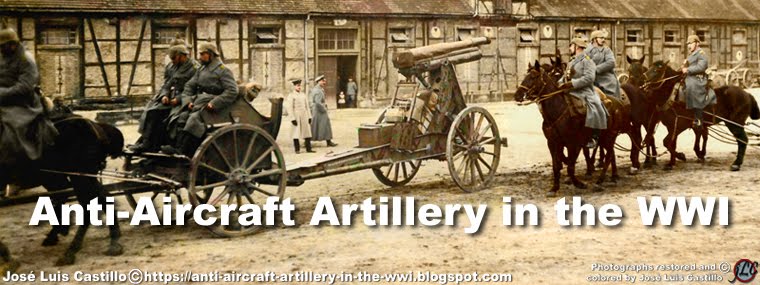An Imperial Austro-Hungarian Navy anti-aircraft gun:
the Marine-Ballonabwehrgeschütz (BAG) Skoda M1912 7-cm L/30.
An anti-aircraft artillery position of the Austro-Hungarian Navy, belonging to a Battery deployed along the coast and close to an Adriatic port, from which the mouth of the port and the can be seen, the right of the photograph, the elements of signage of the same. On the right, in the foreground, a Bulgarian officer.
The gun is one of the most unknown of the A-H Anti-Aircraft Artillery, despite its importance, especially during the first years of the war. It was first used by the Imperial Austro-Hungarian Navy on ships, ground fixed positions and 2-ton Austro-Fiat trucks. Later it was used by the Army, both in fixed ground positions and on the aforementioned trucks.
The crews, in a first stage, were formed by marine artillerymen, later they were combined with army troops, who were instructed in the handling of the guns..
xxxxxxxxxxxxxxxxxxxxxxxx
Un cañón antiaéreo de la Armada Imperial Austro-Húngara:
el Marine-Ballonabwehrgeschütz (BAG) Skoda M1912 de 7-cm L/30.
Una posición de artillería antiaérea de la Marina Austro-Húngara, perteneciente a una Batería desplegada a lo largo de la costa y próxima a un puerto del Adriático, del que se observa, a la derecha de la fotografía, la bocana del puerto y los elementos de señalización del mismo. A la derecha, en primer plano, un oficial búlgaro.
El cañón es uno de los más desconocidos de la Artillería Antiaérea A-H, pese a su importancia, especialmente durante los primeros años de la guerra. Fue utilizado, primero por la Marina Imperial Austro-Húngara, tanto sobre navíos, posiciones fijas terrestres y camiones Austro-Fiat de 2-ton. Posteriormente fue utilizado por el Ejército, tanto en posiciones fijas terrestres como sobre los mencionados camiones.
Las tripulaciones, en una primera etapa, estaban formadas por artilleros marinos, posteriormente se combinaron con tropas del ejército, a las que instruyeron en el manejo de los cañones.
xxxxxxxxxxxxxxxxxxxxxxxx
Posted by Jose Luis Castillo © 2022- Anti-Aircraft Artillery in the WWI


